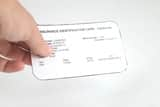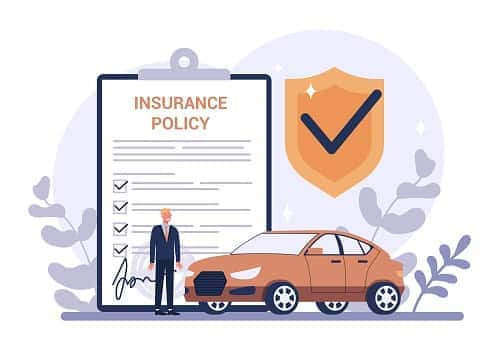- Do you need a front license plate?
- Why do some states require front license plates?
- Which states require a front license plate?
- Is it illegal not to have a front license plate?
- Which states do not require front license plates?
- What are the penalties for violating the front plate law?
- Requirements for mounting a front license plate
- Auto insurance FAQs
Do you need a front license plate?
If you live in a state where it's required by law, you need to have a license plate on the front and back of your vehicle. It helps law enforcement identify vehicles if they're involved in a crime or traffic violation.
"Having two plates (front and back) makes it easier to locate stolen cars. This is especially true with police departments that use license plate reader systems," says Steve Albrecht, a retired San Diego police officer.
Why do some states require front license plates?
In addition to making the vehicle easy to identify, there are a few other reasons for requiring front license plates. They include the fact that the reflective nature of the front plate can increase a car’s visibility to oncoming traffic, making it easier for cameras and lasers to capture red-light violators and toll violations.
License plate readers (LPRs) use a high-speed camera to photograph passing cars, identify the license plate number, and check it against a "hot list" of violators and stolen vehicles.
It's not just car-theft victims who benefit from front plates. "A big advantage to having both plates is that witnesses and victims have a better chance of seeing the license plate of suspicious vehicles involved in crimes regardless of which way they're driving," says Trooper Tyler Weerden of the Connecticut State Police.
Many people consider them downright unsightly, especially owners of exotic or classic cars. Still, it's hard to deny that law-enforcement capabilities and public safety are improved by the ability to identify a car from either end.
Which states require a front license plate?
Ultimately, whether or not a state requires a front license plate is up to that state’s legislature. The states that require a front license plate are:
| State |
|---|
| Alaska |
| California |
| Colorado |
| Connecticut |
| Hawaii |
| Idaho |
| Illinois |
| Iowa |
| Maine |
| Maryland |
| Massachusetts |
| Minnesota |
| Missouri |
| Montana |
| Nebraska |
| Nevada |
| New Hampshire |
| New Jersey |
| New York |
| North Dakota |
| Oregon |
| Rhode Island |
| South Dakota |
| Texas |
| Utah |
| Vermont |
| Virginia |
| Washington |
| Wisconsin |
| Wyoming |
Is it illegal not to have a front license plate?
You must have a license plate in every state to operate a vehicle on public roads. The state's department of motor vehicles issues plates, and in some states, the law only requires one plate at the rear of the vehicle.
However, in the 30 states listed above, you must also have a front license plate. You could face fines if you violate the front plate law by driving without a license plate on the front of the car.
Which states do not require front license plates?
Most states require two license plates -- front and back. But several states only require a rear plate. They are:
| State |
|---|
| Alabama |
| Arizona |
| Arkansas |
| Delaware |
| Florida |
| Georgia |
| Indiana |
| Kansas |
| Kentucky |
| Louisiana |
| Michigan |
| Mississippi |
| New Mexico |
| North Carolina |
| Ohio |
| Oklahoma |
| Pennsylvania |
| South Carolina |
| Tennessee |
| West Virginia |
What are the penalties for violating the front plate law?
If the police stop you, you may have to pay a fine. In some states, a front license plate violation is merely a fix-it ticket, meaning you must add a plate and verify it with the local police.
The ticket goes away once you add the plate to the front of the vehicle and have it checked by the police. A front-plate ticket shouldn't affect your car insurance rates in most instances.
"It's not uncommon for troopers to stop vehicles for license plate violations. Whether a ticket or verbal warning is issued depends upon each situation," says Trooper Weerden.
Requirements for mounting a front license plate
Vehicle codes differ from state to state, so not all requirements are the same for mounting your front license plate. In general, your plate must be:
- Clearly visible
- Securely fastened
- Unable to swing when mounted
- Mounted right side up
- No more than 60 inches off the ground
- Uncovered
- Intact, with its original reflective coating
Sources:
- Fix-it ticket, “What is a fix-it ticket”, Accessed June 2022
- Department of motor vehicles, “Does D.C. require front license plate”, Accessed June 2022
Auto insurance FAQs
What is a valid license plate?
All 50 states, the District of Columbia, Native American tribes and five U.S. territories all have specifications for the appearance of license plates and what makes them valid.
License plates for passenger vehicles usually have five to seven characters, with options for specialty or vanity plates, which can have up to 8 characters in some states. All states use a mix of letters and numbers.
Plates usually require current tags to be valid. In some states, new tags are required every year, while others renew them every two or more years.
Can I put my license plate in the front windshield of my car?
States law determines how license plates must be mounted. The law may specifically say you can’t place the plate on your windshield. However, the plates must be securely fastened, so they don't swing. They must be clear, visible, upright, and the required number of feet off the ground. That means the windshield likely isn’t a legal location for your plate.
If an officer pulls you over, you may get a fix-it ticket requiring you to mount your license plate correctly to the bumper or grill. Besides that, a license plate on your windshield can cause serious harm if you're ever in an accident. It’s made of sharp metal and can become a projectile, harming you or your passengers.





